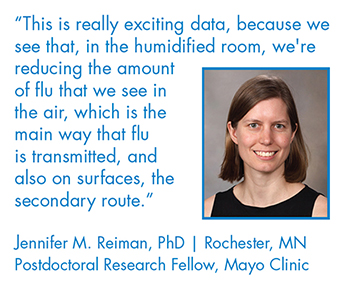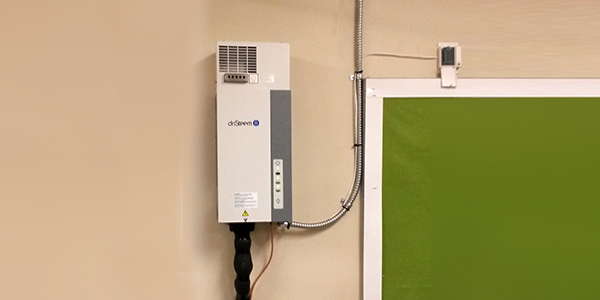Humidify to Reduce Respiratory Virus Transmission
Can altering indoor humidity reduce transmission of respiratory viruses? That question prompted Jennifer Reiman, PhD,
the Mayo Clinic, and a collaborative partnership operating under the banner Integrated Science Education Outreach
(InSciEd Out) to embark on a pilot study.
Mayo Clinic Aldrich Nursery
Can altering indoor humidity reduce transmission of respiratory viruses? That question prompted Jennifer Reiman, PhD,
the Mayo Clinic, and a collaborative partnership operating under the banner Integrated Science Education Outreach
(InSciEd Out) to embark on a pilot study.
Known Concerns
• Student absences increase during winter, and children are the main introducers of influenza into households.
• Missing ten percent of school days in a year for any reason predicts low student achievement.1
• School budgets in many states are based on the average daily attendance at a school.
• Total economic burden of influenza in the USA is greater than $87 billion per year.2
Hypothesis
Increasing relative humidity (RH) to 40 to 60% in classrooms will reduce the capacity of influenza to survive on surfaces or spread between classmates as aerosols.
Approach to the Study
Conduct a study to answer whether increased humidity impacts the following:
• Presence and quantity of viruses and the transmission of viruses via airborne particles and surfaces
• Survivability of influenza (ability of samples to infect cells in culture)
• Influenza-like illnesses and student/staff absences
Two-month Pilot Study
This non-invasive study in four preschool classrooms at the Aldrich Memorial Nursery School in Rochester, MN, was
conducted without collecting clinical data from students or staff. Instead, while staff and students went about their
business teaching and learning, air and surface samples were collected from classrooms for analysis in the Mayo Clinic
lab.
From January 25 to February 23, 2016, two classrooms were humidified with steam humidifiers donated by DriSteem,
while two identical classrooms were not humidified. From the beginning of humidification through March 11, Dr. Reiman and her team collected attendance data and the following samples from all four classrooms:
- Air samples with a cyclone sampler, which collects and sorts airborne particles in separate chambers from smaller
than one micron to more than four microns in diameter - Surface samples from paper-wrapped markers, blocks, and Play-Doh utensils
that had been handled by students during class times
A total of 650 samples were collected from the classrooms — 360 air samples and 290 surface samples. Half of the samples were from the humidified rooms and half from the unhumidified rooms.
Back in the lab, paper from the wrapped objects was dusted for fingerprints, which were cut out of the paper and put into media. Media containing samples from the cyclone sampler and from the fingerprint searches were prepared for
analysis through a series of vortexing, incubating, and centrifugation steps that ended with each sample in a separately labeled solution. Solutions were then subject to a process that amplifies RNA sequences specific to influenza A.3
Influenza-positive Samples in Humidified vs. Unhumidified Rooms

Influenza Infectivity in Humidified vs. Unhumidified Rooms
Research has established that flu outbreaks can be predicted 14 to 16 days after outdoor humidity bottoms out in the continental United States.4 Therefore, in order for the pilot study to be instructive, the humidifiers were turned off on
February 23 in response to Rochester’s seasonal increase in outdoor humidity.
A subset of 45 influenza-positive samples from the beginning of humidification through March 11 were tested in cultures to see if they were able to infect cells (in a plastic dish). Of these 45 samples, 27 were from unhumidified rooms, and 18 were from humidified rooms.
Testing cultures for infectivity is a secondary test for flu that is more stringent than testing for presence. The infectivity results were even more remarkable than the presence results. Of the 45 samples tested, 16 resulted in infectious
cultures:
3 of the 18 cultures (17%) from humidified rooms tested infectious.
13 of the 27 cultures (48%) from unhumidified rooms tested infectious.
Student Absences
While the sample size is too small to be statistically significant, this is worth noting: During the period of elevated humidity in January through the end of the study in March, there were ten student absences due to influenza-like
illnesses reported. Seven were from unhumidified rooms, and three were from humidified rooms.
Conclusion
Steam humidification resulted in a significant reduction in the total number of influenza-positive samples in the air and on surfaces, viral copies, and viral infectivity. “This is the first prospective study suggesting that exogenous
humidification could serve as a scalable NPI [non-pharmaceutical intervention] for influenza or other viral outbreaks.”5
Citations
- Henderson T, Hill C, Norton K. 2014. The Connection Between Missing School and Health: A Review of Chronic Absenteeism.
- Molinari NA, Ortega-Sanchez IR, Messonnier ML, Thompson WW, Wortley PM, Weintraub E, Bridges CB. 2007. The annual impact of seasonal influenza in the US: measuring disease burden and costs. Vaccine 25:5086-5096.
- Influenza is an RNA virus, so Scientists in the Mayo Clinic lab amplified RNA sequences that were specific to influenza A using quantitative real-time polymerase chain reaction (qRT-PCR).
- Shaman J, Pitzer VE, et al: Absolute humidity and the seasonal onset of influenza in the continental United States. PLoS Biol 2010,8(2):e1000316.
- Reiman JM et al. 2018. Humidity as a non-pharmaceutical intervention for influenza A. bioRxiv. doi: https://doi.org/10.1101/273870
Resources
For more information on the equipment mentioned in this case study:
Start a Project
Expert Partner: A local DriSteem rep will work with your facilities team to identify the best solutions available for your application. They will review existing systems and spaces to determine the best way to reach the ideal RH range to improve processes and protect your valuable equipment, materials, and people.


